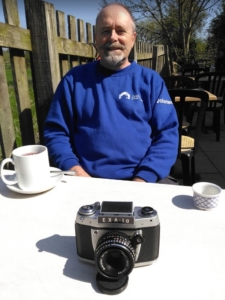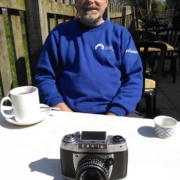German film cameras
Report from HE Translations marketing representative Mike Gayler
First let me say that I am no expert in this field – I have a modest collection of analogue cameras, most of which are European, manufactured during the period 1955 – 1975. They are generally the sort of camera that a family man (and it usually was the man) would have taken on holiday and to weddings, or a camera that would have been proudly sported by the enthusiastic, albeit cash-poor, amateur photographer.
There’s a list of technical resources at the end of this piece; if I’ve used something from your site and not listed it, then please let me know and I’ll edit and credit you. Otherwise all errors are mine.
The great thing about these cameras is that they can now be bought relatively cheaply (less than £20) and usually work well. These cameras have fascinating histories – when holding one you can sometimes sense those family holiday trips, and family get-togethers. Film photography has had something of a revival in recent years, partly as a result of the commercial efforts of The Lomography Company, but also due to many people wanting to take more time and learn how to put more skill into their photographic efforts and translate that into quality images.
The German cameras in my collection can be split into three categories. All three categories were manufactured in Germany, with the first two being from the German Democratic Republic (East Germany) and from the Federal German Republic (West Germany) and both sold under their original makers’ names. The third category is cameras manufactured in West Germany, yet branded as British and sold in the UK while retaining all their technical features but changing their original names, with this name “translation” presumably driven by marketing or brand-promotion strategies.
I will not bore readers by repeating a whole chapter of German 20th Century history, but, for the younger ones, suffice it to say that East Germany was that part of Germany under the Soviet sphere of influence after World War II, and West Germany was in the British, American and French sphere of influence. This state of affairs existed until 1989 when Germany reunited.
Before 1939 Germany was the world leader in optical equipment including cameras, microscopes and lenses. Companies from this period include many that are still well known today such as Zeiss and Leica, and others that will be less famous (like Exakta, Voigtländer, Wirgin and Rolleibut), which may ring a bell in the memories of those of ‘a certain age’.
After 1945 the fortunes of these organisations were wrapped up in world events. Factories finding themselves in the Soviet zone were sometimes dismantled and removed to the Soviet Union as war reparations – the main example is the Carl Zeiss factory in Jena, which was relocated to Leningrad as part of the KMZ production line. The ownership of Ihagee is an interesting case study. Ihagee was a Dutch / German camera manufacturer based in Dresden, which found itself in East Germany in 1945, and as such was nationalised. However, on several occasions the original owners attempted to bring legal cases against the East German government in order to reclaim their property. Ihagee cameras were, for a time, produced in East Germany and Ihagee-West cameras made in Western Europe and Japan.
A different story is that of the Wirgin company of Wiesbaden. The Wirgin brothers were Polish Jews who left Germany for the USA in 1938. During the war the factory continued production of cameras under the Adox brand until the factory was destroyed. After the war Henry Wirgin returned to Germany and restarted production under his own brand, which continued until 1972.
East German camera manufacturing was increasingly centralised in one publicly owned corporation (VEB : Volkseigener Betrieb), known as Pentacon. Pentacon had a number of brands, which were exported to all corners of the world. The most famous of these brands would be Praktica – these were (generally) good quality, solid Single Lens Reflex cameras marketed to ‘serious amateur photographers’ and sold in the west at very competitive prices. Praktica cameras were robust and reliable even if they were not very stylish. The other main Pentacon brand was Ihagee, as mentioned above, with their Exakta and Exa ranges. Exakta cameras were innovative, and they were designed for use by professional photographers with high technical standards. The Exa cameras were the consumer range of a similar design. A vast array of adaptors and lenses were made for Exaktas and Exas, including microscope adaptors, and stereoscopic lenses to translate subject matter into quite different forms.
The story of Zeiss Ikon is very complicated after 1945 as it involved the company operating under two similar names : Zeiss Ikon AG Stuttgart (in West Germany) and Zeiss Ikon Dresden (in East Germany), although the name VEB Kinowerke Dresden was used from 1958 to avoid trademark disputes, until it merged with VEB Pentacon in 1964. There is a graphical timeline of this difficult situation at amerapedia.fandom.com/wiki/Zeiss_Iko.
One of my favourite cameras – the Werra – was made by Zeiss Ikon in East Germany. The Volkskamera (people’s camera) was named after a river near the factory and features a beautiful minimalistic design, unique operation and mechanics. These cameras were the product of the factory having a team of engineers who had returned from war service, but had no role in the company, so they were given free rein to design a camera. The Werra range was the result of this innovation.
The quality control and production values of East German Cameras, (like those from West Germany), are generally very high. One occasionally sees accusations that production targets in communist countries overrode the need for quality of product; my impression is that, although this may have been partly true for cameras made in The Soviet Union, it was not true for Germany. Equally, there are the occasional assertions on various forums – generally from America – that East German camera production lines were staffed by forced labour or by political prisoners; personally I have seen nothing to support these assertions.
If the camera industry in East Germany seems complicated then the capitalist West Germany is no less complex.
An illustration of some of the difficulties in following the West German camera industry can be seen in the Ilford Sportsman, a very nice camera to use, and one that evolved over a number of years. Initially Ilford were marketing cameras made in West Germany by Kodak AG of Stuttgart, but in an attempt to appeal to a wider market, they came to an arrangement in 1957 with Dakora Kamerawerke in Reutlingen to rebadge the budget Dacora Dignette as an Ilford Sportsman. This camera was also sold in Italy as the Ferrania Lince, in America as the AMC M135, a Hanimex in New Zealand, and in Spain translated as a Certex camera! There are around 16 main variants of the Ilford Sportsman, but collectors tend to think that some of these variations are from the Dacora factory using up end-of-line production parts in conjunction with newer parts – waste not want not!
One of the oldest names in German photographic history is that of Voigtländer. This company dates back to around 1840 and they produced the first zoom lens and the first camera with a built-in electronic flash. Sadly the later history of the company is less impressive with production eventually being moved to Japan.
Thankfully for the collector, or anyone who wants to try their hand at old-style photography, not only are these cameras still available, but the manuals are too. Many manuals are available as pdf scans from the amazing resource maintained by Mike Bukus at butkus.org/chinon/index.html but also the originals are frequently sent with the camera or can be purchased online. Don’t forget that if you find a manual in its original language and need it translating into your language then HE Translations can always help you out!
To purchase film I’d suggest a new start-up company analoguewonderland.co.uk for fair prices and good service. For film processing I use Snaps photo services in Bournemouth who will scan your negatives to CD for you : snapsphotoservices.com
I’d encourage you to try analogue photography – particularly with an old German camera – have fun!
Index to German Camera Makers :
camerapedia.wikia.com/wiki/Category:German_camera_makers
Adox
camerapedia.wikia.com/wiki/Adox
Camera manuals
butkus.org/chinon/index.html
Dacora (see also Ilford Sportsman)
camerapedia.wikia.com/wiki/Dacora
Ihagee (Exa & Exakta)
camerapedia.wikia.com/wiki/Ihagee
Ilford Sportsman Range (Dacora Dignette):
photomemorabilia.co.uk/Ilford/Index_Sportsman.html
KMZ :
en.wikipedia.org/wiki/Krasnogorsky_Zavod
Leica and its fall:
previously an account was available at: lausch41.com/hochmut.htm (in German)
Pentacon :
en.wikipedia.org/wiki/Pentacon
Voigtländer
en.wikipedia.org/wiki/Voigtländer
camerapedia.wikia.com/wiki/Voigtländer
Werra :
cameras.alfredklomp.com/werramatic/
camarasclassicas.blogspot.com/2010/09/werra-design-that-came-from-east.html
Wirgin :
cjs-classic-cameras.co.uk/wirgin/wirgin.html
camerapedia.wikia.com/wiki/Wirgin
Zeiss Ikon (East and West)
camerapedia.wikia.com/wiki/Zeiss_Iko
The decline of the German Camera Industry
klassik-cameras.de/WestdeutscheSLR.html (in German)




